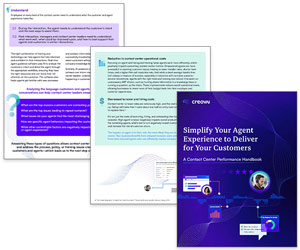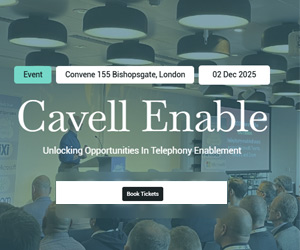Our panel of experts look at how Workforce Management technology is expected to change over the next few months and years.
What can we expect in the next few years?
Traditional forecasting models will be replaced

Ashley Unitt
Advances in computer simulation modelling, machine learning, predictive (and even prescriptive) analysis in the world of ‘Big Data’ means that traditional forecasting models need to be replaced with tools that can actually handle the real-world complexities that exist in the modern multi-skilled, multichannel service centre.
We can expect a lot of disruption in the market over the next few years.
With thanks to Ashley Unitt at NewVoiceMedia
The focus will be on bringing all metrics into one central function
Workforce management is becoming much more focused on driving efficiencies by linking contact centre processes to the rest of the business, to facilitate a broad view of how different departments are performing and influencing each other.
This is particularly true when it comes to back-office integration. Traditionally, it’s been difficult to measure productivity in the back office but new systems are now available that track back-office performance and link this to the contact centre.
The increasing need for fully integrated systems means that we’re also seeing a growing demand for dedicated workforce management systems that bring all your metrics into one central function.
Collaborative systems will help raise morale and agent satisfaction

Andy Smith
The true value of agents is starting to be more appreciated and this is reflected in a greater number of collaborative systems that engage agents and give them ownership of the customer experience, and the ability to make a real difference.
Many changes to workforce management systems will involve using time more effectively. For example, by automatically identifying time slots that are less busy and using this time in a strategic way by scheduling coaching sessions, including e-learning.
With thanks to Andy Smith at EvaluAgent
Increased automation will save managers from tedious tasks
In the near future, WFM users can expect to have more and more of the tedious, time-consuming and error-prone tasks taken care of by the application.
This will leave them more time to focus on planning for success and collaborating with colleagues in other departments to deliver a consistently great customer experience.
Bring Your Own Device will help improve schedule adherence
Bring Your Own Device (BYOD) enables agents to use their own devices such as smartphones and tablets in the workplace for work-related tasks.
Over the next few years, enabling agents to bring their own devices will have a highly motivating effect, resulting in more active and productive agents. It will also enhance workplace productivity in terms of consistent schedule adherence and other productivity metrics, as well as improve agent engagement, service level and customer satisfaction.
E-Learning solutions can make use of unproductive time
Agents should have a comprehensive understanding of their role in the contact centre and the services they provide to customers.
Providing dedicated e-learning that can be integrated into classroom training, while also remaining self-paced for agents’ convenience, reduces agents’ time away from dealing with customers. It can also can be undertaken during time that otherwise would be unproductive.
With thanks to Chris Dealy at injixo
Apps will enable a greater work/life balance

Dave Vernon
Workforce management software needs to be accessible from multiple devices and places and needs to be able to be tailored for members more easily than is currently possible. The cloud and app capability is going to be the key differentiator for WFM suppliers.
Apps will engage the workforce giving them accessibility to key “work life” information on every desktop, from home and on the move on their smartphone.
With thanks to Dave Vernon at The Forum
WFM will start predicting multiple tasks and media within one interaction
One challenge that faces contact centres is the move from task-orientated multichannel work to more of an omni-channel world. Previously, routing to agents was on a task-by-task basis – the call came through, the agent completed the task.
Now contact centres have to be prepared to deal with one interaction that involves multiple channels. For example, a customer will call and refer to an email they sent, which the agent will have to respond to once the call has finished. Or a query may start as an email then move to a live chat.

Stephen Wright
The challenge here for workforce management technology is that it’s got to start predicting multiple tasks and media within one interaction, which creates many more variables.
We expect to see workforce management technology getting much better at working in an omni-channel way – managing that complexity and making sure agents can handle multiple tasks within a single interaction.
With thanks to Stephen Wright at Azzurri Communications
Automated speech analytics tools will measure agent performance
The next big thing in workforce management is automation, especially with speech analytics. Traditional manual analysis of voice interactions only covers a small sample size of total calls and is unrepresentative of the total volume of interactions.
Using automated speech analytics tools to measure agent performance will soon become the norm in contact centres, measuring customer interactions phonetically to detect and resolve issues as they arise. With increasing emphasis on social channels for customer interaction, automated analysis will cover both voice and text interactions.

Lucille Needham
Automated training processes will help lower costs and improve skills
Automated training processes will also gain traction, as they lower costs and improve organisational skills. Such software will help identify the skills and profiles of top performers, so that training can be provided to lower performers.
Businesses can then look to improve the listening skills, empathy, product knowledge and sales skills of their employees, which, in turn, will help achieve higher quality customer service.
With thanks to Lucille Needham at Genesys
Self-service will focus on managing personal development
For employees, self-service is developing into something beyond choosing their own schedules. It is now about managing their own performance, skills and development.
Employees can now monitor their performance and adherence and identify and take control of their own training requirements. This can all be done remotely.
Schedule adherence will be introduced for back-office processes
Intraday management is also changing its focus. Desktop monitoring provides a means to introduce schedule adherence for back-office processes.
This will help to identify process issues as well as provide accurate timings for forecasting purposes.

David Evans
Gamification will help to drive performance and engagement
Gamification has also made an entrance and is now becoming the standard mechanism to drive performance and improve the engagement of employees.
It has now become apparent that a simple game dynamic can make a huge impact on individual or team performance.
With thanks to David Evans at Business Systems
Mobile devices are enabling effective homeworking
The ever-expanding use of mobile devices at work extends the scope of workforce management. Workers based at home or on the road can become part of the contact centre environment and of a workforce management approach.
Increasingly, updates can be sent and received, giving the status of jobs undertaken; projects completed and future work planned.
This capability represents a major benefit for every business – from telesales firms employing home workers to roadside assistance companies scheduling technicians.
The cloud will allow remote agents to log into the contact centre
The cloud will continue to have a major impact on workforce management. Agents can be based anywhere in the world and they can log on to the contact centre at any time.
Whenever demand is high, businesses can use analytics to tap into an extended workforce, assess skills required for each job, and then sending alerts to appropriate staff, giving them the opportunity to log onto the contact centre and start working – even at short notice.
Systems will begin to monitor quality too

Jeremy Payne
Beyond planning, scheduling and forecasting resources either on site or remotely, we also see the concept evolving to encompass call recording and “real-time speech analytics” to ensure agents are using the right phrases and keywords from a regulatory compliance perspective, for example, when giving financial advice, or to improve conversion rates, when promoting a product or service.
Being able to go beyond pure workforce management to manage “quality” is a key differentiator in this evolution and optimisation of customer experience.
With thanks to Jeremy Payne at Enghouse Interactive
Integration of long-term and short-term planning tools
Tighter integration of long-term resource planning tools and short-term WFM products will align strategic hiring and resource plans with day-to-day operations.
This will serve to smooth out operational bumps, especially for businesses with large seasonal swings in contact volumes, and provide customers with a more consistent service experience across every contact channel.

Brian Spraetz
WFM will spread into the back office and beyond
The spread of WFM into back-office operations will continue to accelerate and expand even further into branch offices, manufacturing, and other business operations, as organisations look to maximise human resources and consolidate support systems.
With thanks to Brian Spraetz at Interactive Intelligence
Artificial Intelligence will schedule the right number of people
Currently in the final stages of development is an outbound workforce management tool that uses an Artificial Intelligence algorithm to successfully schedule the right number of people at the right times for outbound or blended campaigns based on optimum success.

Mike Donohue
This can be based on how much inbound activity is expected (you don’t want customers to queue so you will always need sufficient resource to cover this) but with outbound success rates also factored in so that you can create a schedule that will optimise sales – while agents are not taking inbound calls you want them to focus on outbound – and specifically at times of high contact/high conversion.
With thanks to Mike Donohue at Magnetic North
Identify the channel where an individual agent performs best
Customers like to have the choice of where and how they interact with an agent – will it be in a traditional store, through email, phone or via online chat?
Staffing all of these arenas to the optimum level is key to gaining the upper hand in the reputation game – and beyond just staffing levels, customers want the right agent for the job. A WFM system needs the ability to identify on what platform an individual agent performs best and schedule accordingly.
Integrating with performance management and analytics solutions to provide critical insights is a trend that will continue to grow. A contact centre is chock-full of software that crunches numbers to deliver critical analysis, but the best practices gained need to be readily shared between systems.

Paige McCaleb
The ability to schedule coaching sessions directly in the WFM system
There will be increased premium placed on the ability to schedule coaching sessions directly in the WFM system and see the data of when and on what channel an employee performs her best so as to help agents perform to their best ability.
With thanks to Paige McCaleb from NICE Systems
What can we expect in 5-10 years?
WFM will need to cover all contact channels – including paper faxes
I think an important thing to say is that voice traffic will still be around and still in big volumes. There have been many articles about the death of voice, but in many organisations this still remains the biggest contact channel by a significant proportion. I even know of members still receiving traffic as paper faxes!
The challenge here is having a product that covers all the contact channels as these are only going to keep on expanding. WFM needs to move out of the contact centre and needs to be planning at an “Enterprise Level” with all facets of that organisation’s planning delivered in one system.
With thanks to Dave Vernon at The Forum
Remote agents will become a manageable option for more businesses
Advances in cloud technology will facilitate many changes within the contact centre and how the workforce is managed. Hosted contact centres will become more prevalent and remote agents who aren’t constrained to a physical location will become an option for more businesses.
Managing a remote workforce will create new problems for businesses and will pave the way for the widespread adoption of technologies such as gamification, which can motivate and reward staff using automated gaming mechanisms.
With thanks to Andy Smith at EvaluAgent
More interaction between the contact centre and the back office
We predict a growing level of interaction between the contact centre and the back office. By this, we mean that the same processes in place to manage agents will be extended into back-office processes and environments.

Part of this will be making use of systems that watch, gather and correlate information. Soon there will be so much data to keep track of that it will be hard for even the most skilled workers to pick out trends and avoid the dangers of false correlations.
We predict contact centres will begin investing in – or even acquiring – more technology that watches and learns what is happening amongst customers and in the contact centres.
With thanks to Stephen Wright at Azzurri Communications
WFM will help to provide the “support of things”
The decline of the physical workplace and rise of the virtual workplace will impact on WFM, as organisations will accommodate the move to homeworking to ensure the well-being of their employees. As part of this, employees will be expected to work on any device, and WFM will need to respond to this.
With the “internet of things” now firmly in place, your car, fridge, TV are all internet enabled and can therefore faults report or provide feedback.
On the back of this, WFM will develop to accommodate yet another channel shift and will help to provide the “support of things” via video-assisted customer support.
WFM will provide process guidance for complex issues
With the growth of remote working and increasingly complex interactions, WFM will provide the knowledge base and process guidance to enable remote employees to navigate through complex issues.
It will develop functionality to accommodate virtual teams and will no longer be the preserve of the customer contact areas. All remote workers from the organisation, regardless of function, will use the self-service functionality provided by WFM.
WFM will be able to proactively identify increases in demand
Service delivery will also change shape. Dynamic, automated optimisation of resource will be in place. WFM will be able to proactively identify increases in demand and automatically reschedule based on previous occurrences without the need for manual intervention by a team of real-time analysts.

WFM will also have more meaningful integration to the actual delivery of workload for back-office processes. It will close the loop to not only provide the required number of employees but also allocate the workload and monitor in real time.
Rather than a standalone process based on contacts, WFM forecasting will develop to include the key elements of the customer journey. Third-party data, external feeds, the internet of everything will provide the base data for WFM forecasting parameters, not just contact volumes. This will provide a more accurate method of modelling volumes and improving accuracy.
With thanks to David Evans at Business Systems
Community-based customer support will also need to be accounted for
Looking further ahead, we see the concept of community-based customer support beginning to dominate the scene. Moving beyond the use of remote workers and the connected enterprise, organisations will increasingly be aware that many of the best resources they have to solve a problem exist outside their own organisation.
They may be existing customers sharing information and communicating with other interested parties in user forums or chatrooms. Organisations will increasingly have to ask themselves how can they manage a resource that is effectively a customer and use it to enhance the service they provide.
Being able to marshal customers and the wider social community to self-help and self-heal is going to become increasingly important. It’s a branch of workforce management – but how organisations manage that to ensure quality, consistency and speed of response will inevitably be a difficult challenge when the relevant people are not specifically on their payroll.
With thanks to Jeremy Payne at Enghouse Interactive
Smartphones will take over the standard computer set-up
With the emerging BYOD (Bring Your Own Device) trend and the increased use of mobile devices for workforce management solutions, could we see mobile devices such as smartphones and tablets becoming more and more prevalent in the next 5 to 10 years, overtaking the standard computer set-up familiar in the contact centre?
Mobile devices and BYOD could very well become the lynchpin of cloud-based workforce management solutions in the future.
With thanks to Chris Dealy at injixo
Systems will provide additional flexibility in how schedules are assigned
WFM will become increasingly prescriptive and automated. For example, instead of simply tracking intraday results and reporting on them, the WFM system will determine the changes needed to address discrepancies, and ultimately make changes to queues, schedules, etc. without any user intervention.

Tighter integration with other WFO products, like quality management and employee analytics, will automate the assignment of agent skills used during schedule creation. In response to a continued shift towards work-at-home agents, WFM systems will provide additional flexibility in how schedules are assigned, even letting agents pick the actual days and hours they want to work, while still ensuring that sufficient staff are online to meet customer demand.
The ways in which customers are connected to agents will also evolve. Concepts like customer-choice and behavioural analytics routing will become mainstream.
WFM systems will need to come up with new forecasting techniques as the traditional queuing methods of current products will not adequately support these changes.
With thanks to Brian Spraetz at Interactive Intelligence
The future will be driven by empowering agents to do their best
Contact centres will have to balance this with meeting staffing needs, but I think more mobile technology will be up to the task.
I expect we will also see a shift to a more holistic way of thinking about performance as a whole. Companies will need to look at the entire employee life cycle from hiring to continued training and sustained employee engagement in order to keep high performers on board.
The more a WFM system can integrate and automatically figure out what motivates and keeps an employee performing at their peak, the better chances a company has of reducing attrition and cutting the cost of a high turnover rate.
The future will be driven by creating a performance-driven culture where employees are empowered to do their best work when and where they are most apt to succeed – we’ve seen this trend emerging but I think it will be mainstream and reinforced by 2025.
With thanks to Paige McCaleb from NICE Systems
The distinctions between front and back office will blur
As companies learn to take advantage of the ever increasing masses of data that are now available to them, they will learn to pre-empt the needs of their customers and increasingly automate their reactions.
However this pans out, all parts of the business will know all parts of the customer’s status. The distinctions between front and back office will blur, and those agents that remain in the “contact centre” will be highly valuable creative problem solvers offering massive value to the customer experience.
Flexible working will become the norm
In this environment, where agents become an increasingly valuable company resource, we will have to rethink our approach to scheduling. Agent preference will be the prime consideration, with flexible working the norm.
We will increasingly move away from the idea of forcing adherence to a theoretical schedule dreamed up at some point in the past and move towards a real-time optimisation, where deviations in agent behaviour are as expected as deviations in the forecast workload, requiring a far more nuanced response.
Any workforce management solution will need to work within the routing engine to optimise the workload around the agents, not the other way around.
With thanks to Ashley Unitt at NewVoiceMedia
What do you think will happen to workforce management technology in the coming months and years?
Author: Megan Jones
Published On: 1st Jul 2015 - Last modified: 10th Jan 2025
Read more about - Technology, Brian Spraetz, Business Systems, Chris Dealy, Employee Engagement, Enghouse Interactive, EvaluAgent, Genesys, Intrado, Jeremy Payne, Maintel, NiCE, Peopleware, Scheduling, The Forum, Vonage, Workforce Management (WFM)








































